If your utility bills are sky-high in winter, you might need to make some adjustments to the heat retention of your room. The money you spend on energy bills can be lowered if you are smart enough to use the resources at hand.
Curtains can help make a room warmer because they help keep heat inside the house instead of allowing it to escape out through the windows.
In winters, you lose a massive amount of heat through your windows. However, most people aren’t aware of this simple fact.
The changes you make to your curtains and when you open or close them can greatly affect how much you save on energy bills.
Curtains save heat and make rooms warmer, but only when used correctly. The type of curtains also matters if you want to use them for heat retention.
If you aren’t sure your curtain will be able to keep the room warm, read along to know how exactly curtains help with heat retention.
How Can Curtains Keep a Room Warm?
Simple logic applies to this question; the curtains become a barrier between the cold and hot air passage. The heat escapes through the windows and the cold sets in.
Even double-glazed windows aren’t able to stop all the heat from escaping.
However, if you have a set of thick curtains hanging over your window, you can prevent the heat from escaping the room and keep the room warmer and cozier.
Curtains create resistance, so there will still be some loss of heat particles, but on the whole, most heat particles will meet the barrier and won’t be able to escape the room.
Not only that, but the amount of sunlight you let in during the day matters. The more sunlight you let in during the day, the better it will be for your energy bills.
It will make the room warmer for longer, and you can save on electrical bills by using sunlight as your main heating and light source.
The smart way to retain heat in the room and keep it warm for longer is to shut the curtains as the sun goes down immediately.
This way, the heat particles will not escape and the cold particles won’t penetrate the room.
The curtains will become the ultimate barrier between the two keeping the room warm for longer.

How Much Heat Can Curtains Retain?
Curtains act as insulators; they become a thick barrier and stop the cold and warm air from mixing and making the room colder.
By general rule, the thicker the curtains, the better the result. If you have heavier curtains in your room, you will be able to retain more heat than a room that has lighter curtains.
Choosing the right curtains for your home is essential if you are looking to retain heat, make the house warmer, and save on utility bills.
Insulator curtains come with a lining at the rear end to also help increase insulation.
It limits airflow, but it also helps with noise. If you can’t find insulator curtains, consider adding another layer to your curtains, as this will also add insulation to your existing curtains.
The rear lining doesn’t have to be bulky, and it can be linen or cotton so that your stylish curtains don’t lose their look and style.
How To Choose The Best Curtains To Keep The Room Warm
There is a huge variety of different curtain materials out there, some of which are ideal for helping you keep the room warmer. Here’s a guide for buying the best curtains to retain heat.
1. Blackout Curtains
Blackout curtains are mainly used to keep the room dark, but this doesn’t mean they aren’t great at keeping the room warm as well. The blackout curtain’s main purpose is to keep the light out of the room.
They are also used to retain the privacy of the room. However, blackout curtains are still better than traditional curtains at keeping the room warm.
Compared to conventional curtains, blackout curtains retain heat better and help keep almost any room warmer.
However, you still have to let in some sun during the day to keep the room warm at night. Blackout curtains can be pretty expensive.
2. Thermal Curtains
Compared to blackout curtains, thermal curtains work better at keeping the room arm and retaining heat. They are specifically designed to stop the heat from escaping the room.
Most thermal curtains have a thick foam lining that absorbs the heat during the day, and it warms up the room at night.
In comparison, blackout curtains reflect sunlight and absorb as little heat as possible. Compared to blackout curtains, curtains with thermal lining are more affordable as well.
Be vigilant when buying thermal curtains also – most people will sell blackout curtains claiming they double as thermal curtains, but in many cases that isn’t the case.
3. Thick Fabric Curtains
If you can’t get your hands on thermal curtains, your next best choice is curtains made of thick fabric. They work best at keeping the heat locked in the room.
They are also great at keeping the cold air out and stopping it from mixing with the warm air inside. However, they aren’t on the cheap side either; thick fabric curtains can get very expensive depending on the fabric and style you select.
Conclusion on Curtains Making a Room Warmer
Although thermal or thick curtains aren’t a replacement for central heating or radiators, they do work well enough for you to give your heating tools a bit of a break.
Thicker curtains and thermal curtains are the best way for your home to help retain heat during the winter months and help you save on your heating bills.


